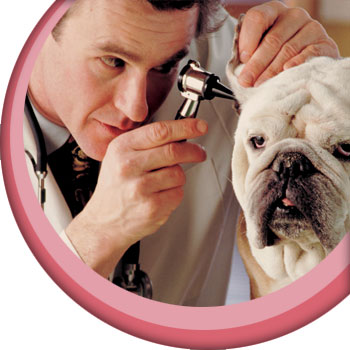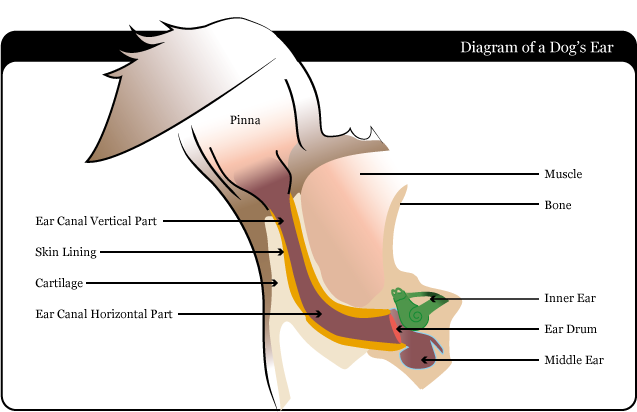Ear Disease in Dogs
One of the most common ear diseases in dogs is otitis externa. This means inflammation of the outer ear, which is made up of the pinna (ear flap) and ear canal. This inflammation is often followed by infection with bacteria and yeasts. Otitis externa is a common condition in dogs and it can cause a lot of discomfort and damage if it is not treated.


Predisposing factors
Things that may make your dog more prone to ear problems include:
• Poor ventilation – this is usually due to hairy ear canals or floppy ears and is more of a problem in some breeds than others. It can lead to accumulation of wax, and creation of a warm, moist environment suitable for bugs to grow.
• Swimming – this creates a moist environment in the ear canal.
• Foreign bodies – most often grass seeds, which can create a place for bugs to grow or cause a lot of pain and irritation.
• Parasites such as ear mites, which are usually picked up from other animals.
• Allergic skin disease – the pinna and ear canal are actually a specialised area of the skin and therefore any inflammatory skin disease may include inflammation of the outer ear.
• Tumours in the ear canal.
Symptoms
This is a list of things you may notice if your dog has otitis externa:
• Scratching the affected ear.
• Head shaking.
• Holding the head to one side.
• Pain around the ear when touched.
• Red ears.
• Smelly ears.
• Discharge visible in the ear.
It is always worth checking your dog’s ears regularly, and you should visit your vet if you are concerned that they may be showing any of these signs.
Diagnosis
When your vet examines your dog they will often use an otoscope to enable them to see into the external ear canal. They will look for signs of inflammation and infection, as well as checking whether the ear drum is intact and looking for any foreign bodies, tumours or parasites. They will also check for any other clinical signs that may suggest an underlying cause, for example skin conditions. They may decide to carry out further investigation such as:
• Taking a sample to check for bacteria, yeast or mites under the microscope. Click here to find out more about Cytology
• Sending a swab to a laboratory for culture and sensitivity. This tells them which bacteria are present and which drugs will treat them most successfully. Click here to find out more about Culture and sensitivity
• They may carry out further examination of the ear under general anaesthetic (with your dog fully asleep) or sedation if necessary as it can sometimes be a bit uncomfortable for your dog if the ear is sore.
Treatment
Your vet may initially suggest treatment for the infection and inflammation in your dog’s ear which will hopefully make them feel a lot more comfortable. This may include:
• Antimicrobial (antibacterial and antifungal) ear drops to treat any bugs. These may also contain an anti-inflammatory.
• An ear cleaner to remove any wax and debris if necessary and therefore allow the ear drops to work better.
• Oral antibiotics (given by mouth) or medication to reduce pain or irritation if needed.
• In severe cases the ears can be flushed (washed out) under general anaesthesia before starting the above treatments.
Any predisposing factors may also need to be controlled. Your vet may suggest regular use of an ear cleaner, especially if poor ventilation and wax accumulation are a problem. If foreign bodies, tumours or parasites are found they can be treated as necessary. In the case of more generalised skin disease, further investigation such as allergy testing may be useful for control of the condition in the long-term. Your vet will be able to discuss any further tests with you if they are needed.
In some dogs, otitis externa can be recurrent (keeps coming back) or difficult to treat successfully. This often occurs if predisposing factors cannot be controlled well enough and these dogs may have chronic (long-term) infection and inflammation. In these cases the condition can become self-perpetuating (it forms a vicious cycle) as long-term damage may occur. The ear canal becomes narrowed and thickened, meaning the ventilation gets even worse and the infection is harder to treat. Another reason for unsuccessful treatment is if there is infection with a resistant strain of bacteria. Certain species of bacteria have developed ways of protecting themselves against antibiotics and are very difficult to treat effectively. Culture and sensitivity testing is especially important for these cases.
In severe long-term cases of otitis externa where treatment with medications has not been successful, surgery can be carried out to remove part of the wall of the ear canal. This allows better ventilation and prevents the bacteria having a suitable environment to grow in. Your vet will be able to discuss this with you if they think it is a good option for your dog.
Disclaimer: This website has been designed to offer information surrounding the use of antibiotics and infection control for pet owners. It does not replace advice from your veterinary surgeon. If you believe your pet is unwell or you have any questions relating to their treatment, please always contact your veterinary surgeon for advice.

